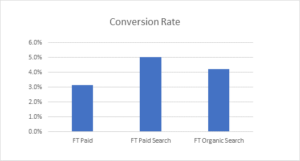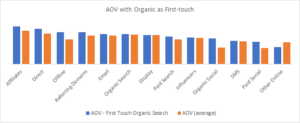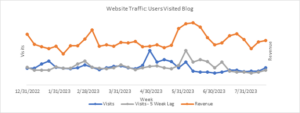
Navigate an unpredictable landscape with actionable, data-driven strategies tailored for your business from the brand down to the local level.

In the world of digital marketing, you have to understand the entire customer journey in order to make informed strategic and resourcing decisions. But, as any SEO practitioner will tell you, it can be exceedingly difficult to gauge the impact of any one digital tactic, never mind a complex web of non-linear user touch points.
So, where to begin? Traditionally, marketers have looked to first-touch and last-touch attribution models to optimize their campaigns for maximum impact. Each approach has its benefits, as we’ll see, but when you layer them together you create something far greater than the sum of its parts: multi-touch attribution.
In this article, you will learn how first-touch and last-touch attribution can be deployed together to reveal the contributions of each channel—including organic search—and transform your understanding of the customer journey, from the initial spark of awareness to the decisive moment of conversion.
The customer journey outlines the various stages a customer goes through while interacting with a product, service, or brand. It begins with the customer’s initial awareness or discovery of the offering and extends through the entire lifecycle of their relationship with the business. This journey typically consists of four key phases:

Evaluation of touch points involves collecting and analyzing data. Data-driven insights empower marketers to make informed decisions, prioritize improvements based on actual customer behavior, and allocate resources efficiently. However, using a single attribution model will only tell part of the story. Full customer journey analysis will require the use of multi-touch attribution.
There are many forms of multi-touch attribution used in marketing. For today’s purposes, we will look at the value of combining first-touch and last-touch attribution models to gain additional understanding of the value of each touch point across the customer journey.
Subscribe to our monthly newsletter.
First-touch attribution places emphasis on the very first interaction a user has with your brand. This initial touch point can occur on various channels, such as social media, organic search, or via referral links. Although it’s a long way removed from the final conversion, there are some key benefits to incorporating first-touch attribution into your digital marketing strategy:
On the flip side, last-touch attribution identifies only the final interaction before a conversion event. Though it’s a relatively one-dimensional metric, last-touch attribution offers various benefits:
While each attribution model offers unique insights, combining first-touch and last-touch attribution provides a much more detailed and nuanced view of the customer journey. The result, multi-touch attribution, allows marketers to understand the entire conversion path and make informed decisions at every stage. In other words, multi-touch attribution will supercharge your insights in various different ways. These are six of the most common.
When using first-touch attribution, clicks are counted based on the first channel that drove a user to the site. Using this methodology empowers marketers to better understand the value of each channel in generating initial site exposure.
When using a typical last-touch attribution model, clicks are counted only for the last channel a user engaged with. This can often over-value contributions from channels that are heavily skewed towards the end of the conversion funnel.
Adopting multi-touch attribution blends the first-touch and last-touch perspectives, distributing credit across the customer’s journey. This approach provides a more detailed view of each channel’s role, from initial interest to final conversion, and mitigates the risk of over-valuing the last interaction or under-valuing the first.

In typical last-touch attribution, conversion rates are based on the channel a user last interacted with. This will tend to value late-journey channels and tactics while ignoring the impact of early-journey efforts.
By also analyzing first-touch conversion rates, marketers can better understand the value of early-journey marketing tactics and channels.

In this analysis, we look at the impact of early-journey marketing on last-touch conversion rates. To do so, we compare the typical channel conversion rate to that of when organic search was the first entry point. This allows us to measure the value of deploying early-journey tactics and evaluate how they impact late-journey performance.
In this particular instance, we found that almost every channel had a higher conversion rate when organic search was the first entry point:

Like analyzing the impact of the first-touch channel on conversion rates, analysis can be conducted to determine the impact of a user’s first entry point on their later order value.
In this instance, we found that when organic search was the first touch point, almost all last-touch channels saw an increase in average order value.

By comparing revenue attribution across first-touch and last-touch, marketers can better understand how much generated revenue is attributed to another channel. This is particularly useful in understanding the role of each channel when guiding users throughout the conversion journey.
In the below example, DAC discovered that 38% of revenue driven by first-touch organic search was later attributed to other channels:

Oftentimes, early-journey research and informational content is under-valued when measured via last-touch attribution. This type of content tends to have fewer immediate conversions. As such, measuring via last-touch will attribute downstream conversions to the final channel.
When viewed on a longer timeline, we found that blog visitors tend to return to the site within five weeks to make purchases. Using last-touch attribution alone, this trend would not have been identified.

Beyond analyzing whether or not blog users convert, we can also look at the impact on conversions. In analyzing, we found that users who visit the blog convert at a higher rate, have higher page views per visit, and a much lower bounce rate.

In the ever-evolving landscape of digital marketing, understanding how customers interact with your brand is essential for success. First-touch and Last-touch attribution models offer distinct advantages, from optimizing awareness-building strategies to refining conversion-focused campaigns. By leveraging the insights provided by these attribution models and layering them together, marketers can create more effective and targeted campaigns, ultimately driving better results and maximizing return on investment.
Navigate an unpredictable landscape with actionable, data-driven strategies tailored for your business from the brand down to the local level.
Navigate an unpredictable landscape with actionable, data-driven strategies tailored for your business from the brand down to the local level.
Navigate an unpredictable landscape with actionable, data-driven strategies tailored for your business from the brand down to the local level.
Subscribe to our monthly newsletter.